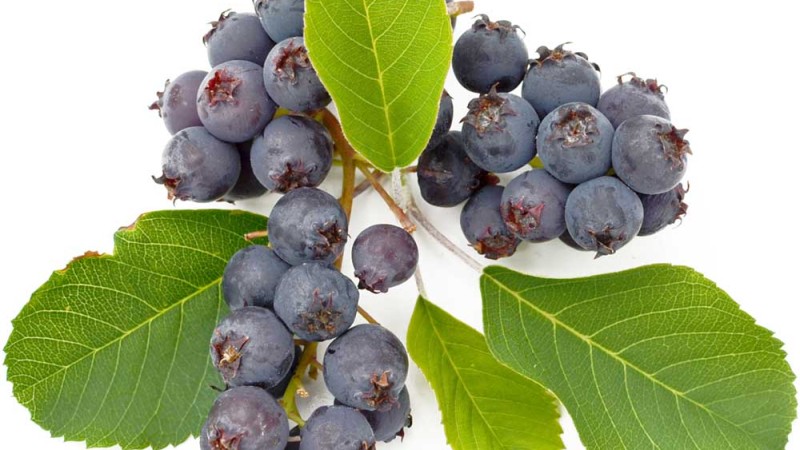
The Saskatoon Berry (Amelanchier alnifolia) belongs to the rose family (Rosaceae) and bears aromatic and sweet fruit similar to blueberries. Is native to Canada and widely cultivated in the Prairie provinces, particularly Saskatchewan, Manitoba, and Alberta. Most quality varieties come from Canadian breeding programs.
Saskatoon berry brings both beauty and benefit to the garden
Saskatoon berries attract birds, add visual interest with their white spring blooms and colorful fall foliage, and provide delicious fruit.
Saskatoon berry is shrub or small tree that grows about 2.5 m tall and 1-2 m wide. Saskatoon plants typically flower from mid-April, with the fruit maturing and becoming ready for harvest in mid-June to mid-July. The small star-shaped flowers are white coloured and appear in clusters of 5 to 20 blooms. The entire plant is soon covered with numerous flowers, which are a valuable source of nectar for bees. The flowers withstand spring frosts down to -5 °C. Saskatoon has unique leaves that are oval to round in shape. Shortly after flowering, the first fruits form. Berries are a pome and dark purple in colour, waxy-coated, round, very similar to blueberries. They have uneven ripening and the sizes varies widely with cultivar grown. Plants begin to bear fruit in the third year after planting. Mature bushes can produce an average of 3 to 4.5 kg of fruit per plant. In autumn, saskatoon surprises with its spectacular autumn color. The orange-red leaves make the flycatcher an eye-catcher in the garden until it drops its leaves. Saskatoons are extremely cold-tolerant, able to withstand temperatures as low as -40 °C. This makes them suitable for regions with harsh winters. The plants are almost not attacked by diseases and pests.
Site and soil requirements
Saskatoons do best in full sun to thrive. They can grow in partial shade, but like all plants that aren't getting their preferred sun amounts, you will get fewer, lower quality fruit and the shrub will be more susceptible to problems. They are tolerant of most soils, but do best in well drained, loam or sandy loam soil. They tolerate clay soil if the location is well-drained and adequate moisture maintained. Planted in a row, it creates a hedge that serves as a shelter and food source for many species of birds. Saskatoon is also resistant to polluted air and copes well with the urban climate.
Planting and care
It is best to plant saskatoons that have previously been grown in a pot. Plant in a hole that is big enough to accommodate the entire root mass. They should be spaced at least 1 - 1.5 m apart from each other. When planted in a hedgerow, they will fill in the space between each plant within five years to form a solid hedge. Keep the soil around newly planted shrubs moist, but not waterlogged for the first 2 - 3 weeks. After that water new plants every week or so, unless it rains. Once saskatoons are well established (after 2 - 3 years) they do not require a lot of water. Do not apply chemical fertilizer. You may apply 2 cm of compost or well-composted manure at soil level. It's important not to allow grass or weeds within about one meter of the trunk of newly planted saskatoons. This is because saskatoons have a very shallow root system that does not compete well with other plants. A better way is to apply a thick layer of mulch in a wide circle around the shrub. An annual application of compost or composted manure in spring is recommended fertilizer for established saskatoons. Both provide slow release of nutrients, perfect for saskatoons.
Pruning
For the first few years after planting, either leave saskatoon plants unpruned to allow them to grow naturally, or continuously train them to maintain a bushy shape. Maintenance pruning involves removing old, weak, and diseased branches, allowing the bushes to receive more sunlight. This promotes growth, fruit formation, and the plant's ability to regenerate. Rejuvenation pruning should only be performed when the saskatoon plants are getting old and losing their vegetative growth vigor. Young plants form natural branches, while mature plants produce very few natural branches. By shortening the annual shoots, we encourage vegetative growth and return the shrub to the desired state. This ensures a balance between fruiting and growth. Remember that regular annual pruning keeps your plants in good condition and maintains the saskatoon's productivity over a longer period.
Uses and health benefits
Saskatoons can be consumed fresh, dried, or made into juice, jelly, jam, compote, syrup, liqueur or wine. Use saskatoons in baking cakes, muffins and pies. They are delicious toppings on ice cream and pancakes. Freezing fruits immediately after harvest is an excellent method for long-term storage, as it helps preserve their valuable nutrients and flavor. The berries are juicy, sweet, with a pleasant taste. The juice has a beautiful crimson-red color. The fruit contain 8-18% sugar, organic acids, tannins, up to 1% pectins and significant amounts of vitamins C, A, B2 and E. Additionally, they are rich in minerals like potassium, magnesium, iron, and manganese. Saskatoon berries offer a range of health benefits, primarily due to their high antioxidant content. These antioxidants, including anthocyanins and flavonoids, can help protect against various diseases like diabetes, heart disease, and cancer. They also possess anti-inflammatory and potential antitumor properties. Additionally, Saskatoon berries are a good source of vitamins, minerals, and fiber, contributing to overall well-being.










